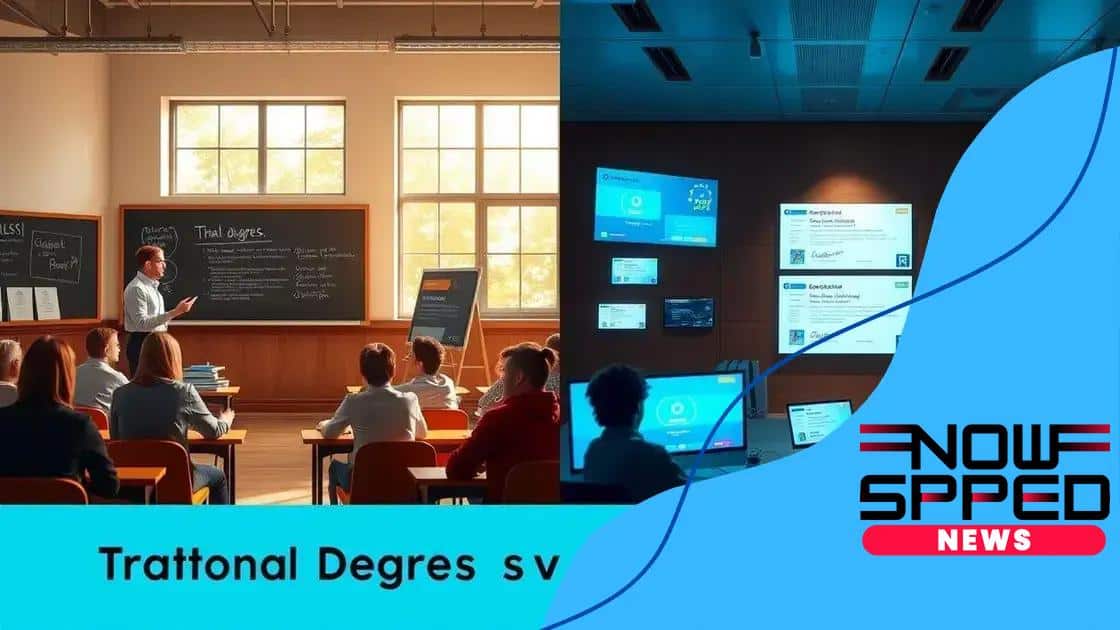Micro-credentialing and the future of education

Micro-credentialing offers targeted, flexible learning opportunities that equip individuals with specific skills, making them increasingly valued by employers seeking relevant competencies in today’s job market.
Micro-credentialing is revolutionizing the way we think about education and learning. Have you ever considered how these bite-sized credentials might fit into your career development?
Understanding micro-credentialing
Understanding micro-credentialing is essential in today’s fast-paced educational landscape. This innovative approach allows learners to acquire specific skills and knowledge at their own pace.
Unlike traditional degrees, micro-credentials focus on the mastery of particular subjects. They offer flexibility and personalization, making education more accessible to everyone.
What is Micro-Credentialing?
Micro-credentialing involves short, focused courses that validate skills. Participants earn badges or certificates that showcase their achievements.
Advantages of Micro-Credentialing
- Provides targeted learning opportunities.
- Enhances employability by showcasing specific skills.
- Offers flexibility in learning schedules.
- Paves the way for lifelong learning.
With the rise of technology, micro-credentialing has become increasingly popular among employers. They value candidates who have verified competencies over those with general degrees.
Participants can choose courses that align with their career goals. Online platforms offer a variety of options in different fields, such as technology, healthcare, and business.
How Micro-Credentialing Works
Most micro-credential programs are simple to navigate. Learners enroll in a course, complete the required modules, and often take an assessment. Upon successful completion, they receive a micro-credential.
This approach fosters a more practical learning experience. Instead of spending years in classrooms, individuals can gain knowledge relevant to market needs quickly.
As we shift towards a skill-driven economy, understanding micro-credentialing will be key for both learners and employers. By embracing this new model, everyone can adapt to changing job demands.
Benefits of micro-credentialing
Benefits of micro-credentialing are becoming more evident as educational needs evolve. These succinct programs are designed to equip learners with practical skills that are directly applicable in the workforce.
One of the main advantages is flexibility. Learners can choose courses that fit their interests and career goals. This personalization allows individuals to take charge of their education.
Key Advantages
- Enhances employability by demonstrating specific skills sought by employers.
- Enables continuous learning, allowing individuals to remain competitive in their fields.
- Provides quick feedback and assessments, ensuring mastery of skills.
- Reduces time and costs compared to traditional degree programs.
Another factor to consider is recognition. Many industries now acknowledge and value micro-credentials as evidence of competency. Employers appreciate candidates who can showcase relevant skills rather than just degrees.
The micro-credentialing process helps learners build their confidence. Earning badges or certificates serves as a motivational tool. It encourages lifelong learning and personal growth, which are important in today’s job market.
Adapting to Industry Needs
Micro-credentialing quickly adapts to changing industry requirements. As job roles evolve, so do the skills needed to succeed. This responsiveness ensures that learners remain current and relevant in their professions.
Each micro-credential typically focuses on a specific topic. Whether it’s digital marketing, data analysis, or project management, learners can address their skill gaps directly. This tailored approach benefits both individuals and employers alike.
Overall, the benefits of micro-credentialing present a powerful opportunity for those looking to advance their careers. By investing in these short courses, learners position themselves for success in a rapidly changing job landscape.
How micro-credentials differ from traditional degrees

Micro-credentials differ from traditional degrees in several important ways. While both aim to enhance learning, they serve different educational needs and career goals.
One key difference is the structure. Traditional degrees typically require years of study and a broad curriculum. In contrast, micro-credentials focus on specific skills and can be completed in a shorter time frame. This allows learners to quickly gain relevant knowledge.
Flexibility and Accessibility
Micro-credentialing is more flexible than traditional education. It offers online courses and resources that learners can access from anywhere. This accessibility makes it possible for individuals with different schedules to pursue their education.
- Micro-credentials are often industry-recognized.
- They focus on practical skills rather than theoretical knowledge.
- Individuals can pick courses that match their career aspirations.
Traditional degrees can be costly and time-consuming. Micro-credentials, however, tend to have lower costs and require less time commitment. This makes learning more accessible to a wider audience.
Another significant difference is the assessment method. Traditional degrees often rely on exams and long-term projects to measure knowledge. Micro-credentials use quick assessments, allowing learners to demonstrate their skills promptly.
Career Focus
The focus of micro-credentials is often on enhancing employability. They equip learners with the skills that are currently in demand in the job market. This targeted approach helps individuals stand out to potential employers.
In contrast, traditional degrees provide a comprehensive education that covers a wide array of subjects. While this broad knowledge is valuable, it may not always align closely with specific job requirements.
Overall, the main differences between micro-credentials and traditional degrees lie in their approach to education. These distinctions highlight how micro-credentials can be a viable alternative for many learners looking to advance their careers.
Implementing micro-credentialing in your organization
Implementing micro-credentialing in your organization can bring transformative benefits. This approach allows employees to gain specific skills quickly and effectively, which is vital in today’s fast-paced work environment.
Start by assessing organizational needs. Determine the skills that are most relevant to your workforce and align them with industry demands. This way, you can create a focused micro-credential program that addresses these requirements.
Key Steps to Implementation
Once you have a plan, follow these key steps to implement micro-credentialing:
- Develop partnerships with educational institutions or providers to offer quality micro-credential courses.
- Create a framework that allows employees to earn and track their credentials.
- Incorporate feedback mechanisms to continuously improve the program based on participant input.
Next, promote the program within your organization. Make employees aware of the opportunities and benefits of micro-credentialing. Encourage participation by highlighting how these credentials can enhance career advancement.
As employees engage in the micro-credentialing process, provide support through resources such as mentorship and access to learning materials. This support can make a significant difference in completion rates and overall success.
Tracking Progress and Outcomes
It’s essential to track the progress of your micro-credentialing program. Monitor which courses are popular and which skills employees are acquiring. This data will help you refine the program and ensure it meets the changing needs of your organization.
Moreover, celebrate achievements. When employees earn their micro-credentials, acknowledge their success. This recognition will encourage others to participate and create a culture of continuous learning.
Overall, implementing micro-credentialing in your organization can lead to a more skilled workforce, better employee engagement, and a competitive edge in the market.
Future trends in micro-credentialing
Future trends in micro-credentialing promise to reshape the educational landscape significantly. As industries continue to evolve, the need for continuous learning and skill development is becoming increasingly vital.
One of the emerging trends is the integration of technology. Online platforms are enhancing the delivery of micro-credentials. This technology allows for personalized learning experiences tailored to individual needs.
Growing Acceptance by Employers
Employers are beginning to recognize the value of micro-credentials. They focus on specific skills rather than traditional degrees. Companies are looking for candidates who exhibit competencies in relevant areas.
- Micro-credentials will likely become standard requirements in many job postings.
- Employers will favor workers who can demonstrate practical skills through these certifications.
- The trend may lead to collaborations between educational institutions and businesses.
Another trend is the rise of gamification in micro-credentialing. By incorporating game-like elements into courses, organizations can increase engagement. This approach makes learning more enjoyable and can lead to higher completion rates.
Emphasis on Soft Skills
Future programs are also likely to place more emphasis on soft skills. Skills like communication, teamwork, and adaptability are becoming crucial in today’s workplace. Micro-credentials can be offered in these areas to prepare learners for diverse roles.
A shift toward interdisciplinary learning will continue. As industries blend, the demand for multifaceted skills will grow. Micro-credentials that combine tech skills with creative problem-solving will be particularly sought after.
In summary, future trends in micro-credentialing highlight the need for flexibility, technological integration, and a focus on both hard and soft skills. These changes will help prepare learners for a rapidly changing job market.
In conclusion, micro-credentialing is reshaping the future of education and training. By offering flexible, targeted learning opportunities, it empowers individuals to gain the skills needed for today’s job market. As more employers recognize the value of these credentials, they will become an essential part of career development. With advancements in technology and a focus on practical applications, micro-credentials help prepare learners for success in various fields. Embracing this innovative approach can lead to a more skilled and adaptable workforce, ready to meet the challenges of a rapidly changing world.
FAQ – Frequently Asked Questions about Micro-Credentialing
What are micro-credentials?
Micro-credentials are short, focused courses that validate specific skills and knowledge, making them ideal for targeted learning.
How do micro-credentials differ from traditional degrees?
Unlike traditional degrees that require years of study, micro-credentials offer flexibility, focus on specific skills, and can be completed quickly.
Why are employers valuing micro-credentials?
Employers appreciate micro-credentials as they demonstrate practical skills and competencies that are relevant to current job market needs.
How can organizations implement micro-credentialing?
Organizations can start by identifying skills needed, developing partnerships with educational providers, and promoting learning opportunities among employees.





